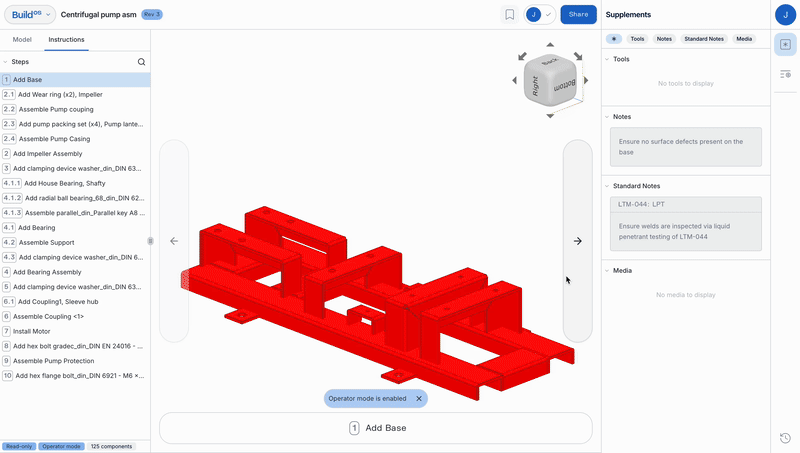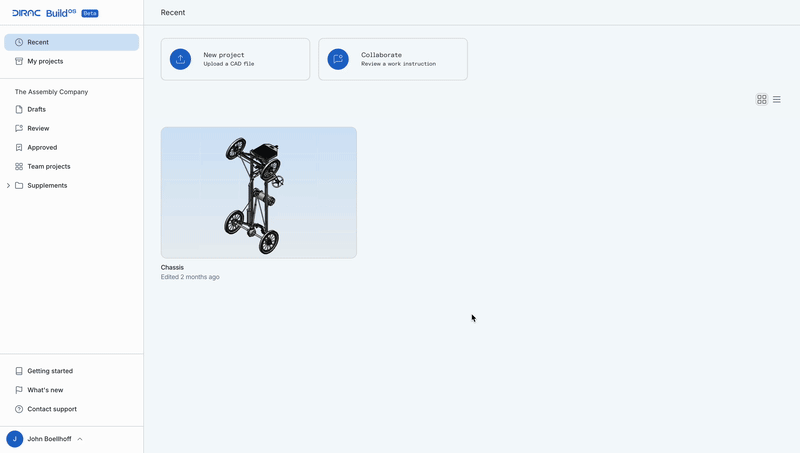Why Using a Work Instructions Template Is the Wrong Approach for Your Factory
Switching from Time-Consuming Word Templates to The Power of Digital Work Instructions
April 17, 2025

Picture this: an engineer hunched over their desk, spending hours copying and pasting your company’s work instructions template and making edits to create a new set of work instructions. Sound familiar?
For decades, manufacturing operations have relied on standardized work instructions templates (Word documents, Powerpoints and PDFs) to guide assembly processes. While these templates once served their purpose, they've become anchors weighing down efficiency in today's increasingly competitive manufacturing environment.
Work instructions templates might seem convenient at first glance. They're familiar, relatively easy to create and have been the industry standard for years. But in an era defined by digital transformation and Industry 4.0, clinging to static templates is like bringing a paper map to navigate a city when everyone else is using GPS.
This article explores why the traditional work instructions template approach is fundamentally flawed and how digital work instructions and work instructions software represents not just an improvement, but a necessary evolution for manufacturing excellence.

The False Promise of a Work Instructions Template
Limited Customization and Flexibility
Standard work instructions templates offer an illusion of efficiency. They provide a basic structure, but quickly reveal their limitations when faced with the dynamic nature of modern manufacturing.
Consider a high-mix, low-volume production environment where product specifications change frequently. Each variation requires template modifications, creating a never-ending cycle of updates. What begins as a simple template for work instructions soon multiplies into dozens of slightly different versions, each requiring manual maintenance.
A manufacturing work instructions template cannot adapt in real-time to changing conditions on the shop floor. When a process improvement is identified or a design change implemented, the template becomes instantly outdated. Engineers must then create new versions, print and distribute them, and ensure old versions are removed from circulation, a process that can take days or even weeks.
Version Control Nightmares
Perhaps the most insidious problem with work instructions templates is version control. In a paper-based or shared-drive environment, multiple versions inevitably proliferate. This leads to confusion about which template is current and authoritative.
Imagine this scenario: An operator uses what they believe is the current standardized work instructions template, only to discover later that they were working from an outdated version. The result? Components assembled incorrectly, specifications missed, and costly rework required. This isn't a hypothetical concern, it's a daily reality for manufacturers relying on template-based systems.
Even with careful file naming conventions and document control procedures, the risk of using outdated templates remains high. Each printed copy becomes a potential liability the moment a process change occurs.
Lack of Interactivity and Engagement
Traditional work instructions templates are inherently static. They typically consist of text and perhaps some basic images or diagrams. This format fails to engage today's workforce, who are accustomed to dynamic, interactive content in their daily lives.
Static templates cannot include videos demonstrating complex procedures, interactive 3D models that can be rotated and explored, or augmented reality overlays that show exactly where components should be placed. These multimedia elements aren't just bells and whistles, they're powerful tools that improve comprehension, reduce errors, and accelerate training.
When operators can see a process demonstrated rather than just reading about it, their understanding deepens significantly. Digital work instructions that incorporate these interactive elements result in faster learning curves and fewer mistakes.

Inability to Capture Tribal Knowledge
Perhaps the most significant limitation of the standard work instructions template approach is its failure to effectively capture tribal knowledge, the invaluable insights, tricks, and techniques known by experienced workers but rarely documented formally.
As noted by global consultancy EY, "Manufacturers can use digital to more easily and effectively capture and convert tribal knowledge into institutional knowledge that stays with the company, and can be more broadly leveraged across the company."
Templates provide no elegant mechanism for preserving this wisdom. When experienced workers retire or leave, their knowledge walks out the door with them. In an era of skilled labor shortages and an aging workforce, this knowledge loss represents an existential threat to manufacturing quality and efficiency.
The High Cost of Sticking with Templates
Reduced Productivity
The time wasted managing work instructions templates adds up quickly. Engineers spend hours creating, updating, and distributing templates rather than focusing on value-added activities like process improvement or innovation.
Operators waste precious minutes searching for the right template, verifying its current, and interpreting sometimes ambiguous instructions. These small inefficiencies compound across shifts, departments, and facilities, resulting in significant productivity losses.
By contrast, companies that have switched to digital work instructions report efficiency increases of anywhere from 50-90%. This dramatic improvement comes from eliminating template management overhead, automating the creation of work instructions and eliminating the fragmented suite of tools (Powerpoint, Word etc) used to create work instructions historically.
Increased Error Rates and Rework
When operators work from outdated or unclear templates, mistakes are inevitable. These errors lead to scrap, rework, and potentially even warranty claims or recalls if defective products reach customers.
The manufacturing work instructions template approach creates a dangerous lag between process changes and updated documentation. During this gap, the risk of errors skyrockets. Digital systems, by contrast, ensure everyone works from the same, current information at all times.
The cost of quality issues extends beyond direct rework expenses. There's also the opportunity cost of production capacity consumed by rework, the potential damage to customer relationships, and the impact on employee morale when they must redo work.
Training Bottlenecks
In today's manufacturing environment, with high turnover rates and a growing skills gap, efficient training is critical. Yet template-based work instructions provide minimal support for onboarding new employees.
New operators must often rely on shadowing experienced workers or classroom training, both of which take valuable time and remove skilled workers from production. Templates alone cannot effectively communicate complex procedures or the nuances of proper technique.
Digital work instructions, however, can reduce onboarding time by up to 50%. This dramatic improvement comes from providing interactive, self-paced learning tools that new employees can reference independently, freeing up experienced staff to focus on production.
Lack of Traceability and Compliance
Modern manufacturing often requires complete traceability for quality assurance, regulatory compliance, and continuous improvement. Template-based systems struggle to provide this critical capability.
When work is performed using printed templates, there's no automatic record of who performed each step, when it was completed, or what issues were encountered. This data must be manually recorded, if it's captured at all, creating additional paperwork and potential for error.
For industries with strict regulatory requirements, like medical device or aerospace manufacturing, this lack of traceability creates compliance risks and complicates audits. Digital systems, by contrast, automatically create audit trails and compliance documentation as a byproduct of normal operations.
The Promise of Digital Work Instructions

Digital work instructions are far more than just PDF versions of paper documents. They represent a fundamental reimagining of how information is delivered to and consumed by manufacturing personnel.
At their core, digital work instructions transform static documents into dynamic, interactive tools that guide workers through complex processes. They provide real-time, step-by-step directions complete with visual aids and contextual information on the best way to complete a task.
What sets digital work instructions apart is their multimedia-rich nature. Depending on the task at hand, they can include:
- Text instructions with precise details
- High-resolution images and diagrams
- Animations demonstrating complex assembly sequences
- Audio recordings for verbal guidance
- Interactive elements that respond to user input
Digital work instructions can be accessed through various devices, including computers, tablets, smartphones, and even AR-enabled smart glasses, making them versatile for different manufacturing environments.
Benefits of Digital Work Instructions
Improved Workforce Productivity
Digital work instructions connect workers to the information they need, when and where they need it. Clear in-context guidance and 3D models improve worker productivity by eliminating the need to search for information or interpret ambiguous instructions.
They boost task precision by offering real-time guidance. Operators can quickly adapt to new tasks, while advanced forms and analytics collect crucial information for data-driven optimization.
The impact on productivity can be substantial. According to a 2023 study published in the International Journal of Advanced Manufacturing Technology, digital work instructions led to tasks being completed 21% faster with a 26% lower perceived workload compared to paper-based instructions
Digital work instructions translate directly to improved throughput and better utilization of resources.
Increased Quality
Exceptional product quality is imperative for both customer satisfaction and safety. Digital work instructions ensure employees have accurate information to increase quality and reduce scrap and rework, improving sustainability.
By ensuring every worker follows standardized, step-by-step procedures, digital work instructions reduce defects and maximize quality control. Real-time guidance and smart tools ensure tasks are done right the first time, while standardized instructions guarantee efficiency and productivity across production lines.
The result is a consistent, high-quality output that meets or exceeds customer expectations, regardless of which operator performed the work or when it was completed.
Accelerated Training
A smaller pool of new hires and a growing skills gap means that companies must transform the way they train their workers. Digital work instructions offer additional context, data, and 3D models to reduce training time and improve retention.
Companies are replacing traditional training with real-time learning, reducing onboarding time by up to 50% for faster employee independence. Interactive and visual guides speed up employee training and onboarding, allowing workers to access easy-to-follow live instructions on a screen or tablet.
Digital work instructions also enable consistent training by sharing best practices across teams for consistent execution and faster employee integration. This approach ensures that every worker performs like your best worker by centralizing all production knowledge and best practices into one accessible and cloud-based solution.
Enhanced Safety
Safety is paramount in any manufacturing environment. Digital work instructions help ensure workers follow safety protocols and guidelines, reducing the risk of accidents and injuries.
By providing clear, visual instructions, digital work instructions can help ensure safety protocols are followed precisely. This is especially important for new employees who may not be familiar with all the safety procedures in place.
Additionally, digital work instructions can include warnings and alerts for potentially hazardous steps, ensuring that workers are aware of the risks and take appropriate precautions.
Cost Savings
Digital work instructions help workers complete tasks correctly the first time, cutting defects, downtime, and training time. Businesses also spend up to 60% less time creating instructions, which allows them to focus more on production.
By minimizing downtime and streamlining work instruction creation, digital work instructions can lead to significant cost savings. Additionally, by reducing errors and rework, companies can save on materials and labor costs.
The return on investment for implementing digital work instructions can be substantial, with many companies seeing a payback period of just a few months.
100% Traceability
Digital work instructions capture crucial production data directly from the shop floor, ensuring complete operational traceability. Every aspect is recorded for continuous improvement purposes.
This comprehensive tracking allows companies to monitor serial numbers, product histories, and workforce data in real-time. Smart forms and checklists simplify compliance, making audits easier and more reliable.
With digital work instructions, managing compliance becomes simpler. The platform offers complete traceability of each step, making audits easier and more reliable.
Digital Work Instructions as a Cornerstone of Industry 4.0
Industry 4.0 describes the current trend of high-efficiency and data exchange in manufacturing technologies. It includes cyber-physical systems, the Internet of Things, and cloud computing. Essentially, it's the fourth industrial revolution, and it's quickly changing the way work is done.
Digital work instructions are a cornerstone of Industry 4.0, integrating seamlessly with other digital transformation initiatives. They enable smart manufacturing practices by facilitating real-time data sharing and analysis, enabling better decision-making and process optimization.
In order to stay competitive in this rapidly evolving landscape, businesses must adopt new technologies and processes. By providing employees with mobile devices that have access to digital instructions, they can easily follow the steps required to complete a task. Additionally, if a process changes, the digital instructions can be updated quickly and easily, without having to reprint and redistribute paper documents.
Key Features to Look for in Work Instructions Software
When evaluating alternatives to traditional work instructions templates, choosing the right work instructions software can be an overwhelming task.
The most effective work instructions software offer these essential capabilities:
- CAD Integration: Look for software that directly imports your CAD models, eliminating manual screenshots and automatically generating assembly sequences.
- Rich Multimedia Support: Beyond basic text, effective work instructions software should incorporate animations and high-quality images demonstrating assembly sequences.
- Robust Version Control: Unlike template-based systems where version control is a constant challenge, quality work instructions software should provide comprehensive revision tracking with a clear audit trail.
For a more detailed breakdown on how to select the right digital work instructions platform for your specific manufacturing environment, explore our detailed guide on the subject here.
Making the Switch: A Roadmap to Digital Transformation
Transitioning from template-based work instructions to a digital system requires careful planning and execution. Here's a proven approach to ensure success:
Assess Your Needs
Begin by evaluating your current work instruction process and identifying specific pain points. Are quality issues stemming from outdated instructions? Is training new employees taking too long? Are you struggling with version control?
Understanding your unique challenges will help you select the right digital solution and establish clear success metrics. This assessment should involve stakeholders from engineering, production, quality, and training to ensure all perspectives are considered.
Choose the Right Software
With a clear understanding of your requirements, evaluate different digital work instruction platforms. Consider factors like ease of use, compatibility with existing systems, scalability, and total cost of ownership.
Request demonstrations and, if possible, pilot projects to see how each solution performs in your specific environment. Pay particular attention to the user experience for both content creators (typically engineers) and consumers (operators on the shop floor).
Pilot Project
Start small with a pilot implementation focused on a single product line or assembly area. This approach allows you to refine your processes and address any challenges before rolling out the system more broadly.
Use the pilot to develop best practices for creating digital work instructions, train your team on the new system, and gather feedback from users. This controlled implementation provides valuable insights while minimizing risk.
Train Your Team
Comprehensive training is essential for both the engineers creating digital work instructions and the operators using them. Develop a structured training program that covers not just the technical aspects of the software but also best practices for creating effective instructions.
Consider designating "champions" within each department who receive advanced training and can support their colleagues during the transition. These individuals become valuable resources and advocates for the new system.
Monitor and Optimize
Once implemented, continuously evaluate the performance of your digital work instructions system against your established success metrics. Gather feedback from users and make adjustments as needed to improve usability and effectiveness.
Use the data collected by the system to identify opportunities for process improvement. This continuous optimization ensures you maximize the return on your investment and continue to enhance your manufacturing operations.
Digital Work Instructions Platform: Transform Weeks into Minutes with BuildOS
Are you still using work instructions templates and spending weeks creating work instructions manually? The math is simple: for every hour your engineers spend taking screenshots, annotating CAD files, copying/pasting templates and formatting documents, that's an hour they're not innovating or solving critical manufacturing challenges.
BuildOS changes this equation dramatically thanks to our purpose-built software designed to transform how manufacturers create and manage their work instructions.
Our platform:
- Determines the optimal assembly sequence without manual input directly from your CAD files
- Generates clear 3D animations visualizing your assembly sequences
- Automatically generates your work instructions in minutes, not days
Ancra Aircraft, a leading aerospace OEM, reduced their work instruction creation time from 4 days to just 1 hour, freeing their engineering team to focus on higher-value activities.
Stop wasting engineering talent on manual documentation. Schedule a demo today and see how BuildOS can revolutionize how you create work instructions.
It’s Time to Leave Your Work Instructions Template in the Past
Clinging to the old approach of using templates to create work instructions is no longer a viable option. These static, outdated tools hinder productivity, compromise quality and stifle innovation. The limitations of these templates simply can't compete with the powerful capabilities of purpose-built software for creating work instructions.
Digital work instructions revolutionize information flow on the shop floor, ensuring that operators have the right information at the right time. The advantages are undeniable: significant gains in productivity, reduced training time, improved quality, enhanced safety, and complete traceability. These benefits translate directly into a stronger competitive edge in an increasingly demanding market.
The transition from outdated templates to digital work instructions is essential for manufacturers who want to thrive in the era of Industry 4.0. Don't let your business fall behind. Explore the possibilities of digital work instructions and unlock a new era of manufacturing excellence.


Dirac is the Assembly Company of the future.
350 5th Ave Ste 4720, New York, New York


